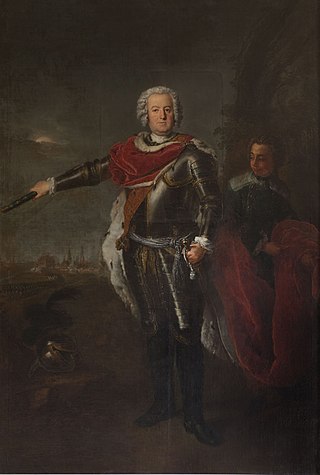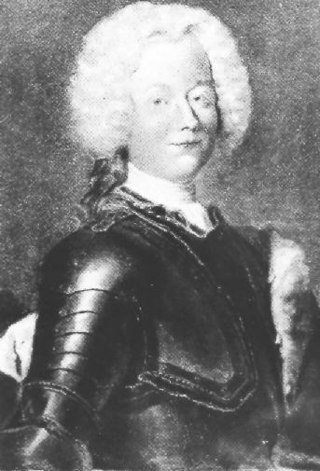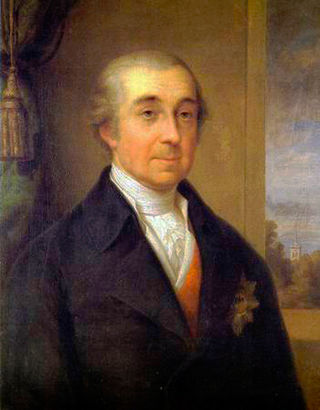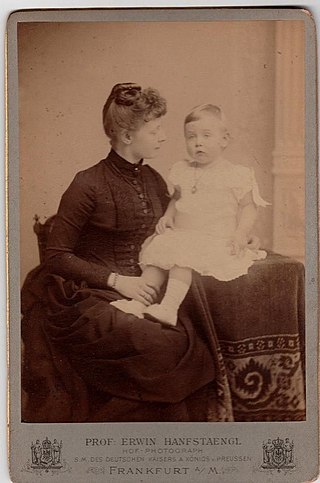The House of Ascania was a dynasty of German rulers. It is also known as the House of Anhalt, which refers to its longest-held possession, Anhalt.

Leopold I, Prince of Anhalt-Dessau was a German prince of the House of Ascania and ruler of the Principality of Anhalt-Dessau from 1693 to 1747. He was also a Generalfeldmarschall in the Prussian Army. Nicknamed "the Old Dessauer", he possessed good abilities as a field commander, but was mainly remembered as a talented drillmaster who modernized the Prussian infantry.

Leopold II Maximilian, Prince of Anhalt-Dessau, was a German prince of the House of Ascania and ruler of the principality of Anhalt-Dessau from 1747 to 1751; he also was a Prussian general.

Anhalt-Dessau was a principality of the Holy Roman Empire and later a duchy of the German Confederation. Ruled by the House of Ascania, it was created in 1396 following the partition of the Principality of Anhalt-Zerbst, and finally merged into the re-united Duchy of Anhalt in 1863. The capital of the state was Dessau in present-day Saxony-Anhalt.

Anhalt-Köthen was a principality of the Holy Roman Empire ruled by the House of Ascania. It was created in 1396 when the Principality of Anhalt-Zerbst was partitioned between Anhalt-Dessau and Anhalt-Köthen. The first creation lasted until 1562, when it fell to Prince Joachim Ernest of Anhalt-Zerbst, who merged it into the reunited Principality of Anhalt.

Leopold of Anhalt-Köthen was a German prince of the House of Ascania and ruler of the principality of Anhalt-Köthen. Today, he is best remembered for employing Johann Sebastian Bach as his Kapellmeister between 1717 and 1723.

Anhalt-Bernburg was a principality of the Holy Roman Empire and a duchy of the German Confederation ruled by the House of Ascania with its residence at Bernburg in present-day Saxony-Anhalt. It emerged as a subdivision from the Principality of Anhalt from 1252 until 1468, when it fell to the Ascanian principality of Anhalt-Dessau. Recreated in 1603, Anhalt-Bernburg finally merged into the re-unified Duchy of Anhalt upon the extinction of the line in 1863.

Leopold I of Lippe was a Prince of Lippe.

Anhalt-Zerbst was a principality of the Holy Roman Empire ruled by the House of Ascania, with its residence at Zerbst in present-day Saxony-Anhalt. It emerged as a subdivision of the Principality of Anhalt from 1252 until 1396, when it was divided into the principalities of Anhalt-Dessau and Anhalt-Köthen. Recreated in 1544, Anhalt-Zerbst finally was partitioned between Anhalt-Dessau, Anhalt-Köthen, and Anhalt-Bernburg in 1796 upon the extinction of the line.

John George II was a German prince of the House of Ascania and ruler of the principality of Anhalt-Dessau from 1660 to 1693.

Frederick I was a German prince of the house of Ascania who ruled the Duchy of Anhalt from 1871 to 1904.

John George I of Anhalt-Dessau was a German prince of the House of Ascania. From 1586 to 1603 he ruled the unified principality of Anhalt jointly with his brothers. After the partition of the principality in 1603, he ruled the principality of Anhalt-Dessau from 1603 to 1618.

Rudolph of Anhalt-Zerbst, was a German prince of the House of Ascania and ruler of the unified Principality of Anhalt. From 1603, he was ruler of the principality of Anhalt-Zerbst.

Emmanuel Lebrecht of Anhalt-Köthen, was a German prince of the House of Ascania and ruler of the principality of Anhalt-Köthen.

Leopold III Frederick Franz, Duke of Anhalt-Dessau, known as "Prince Franz" or "Father Franz", was a German prince of the House of Ascania. From 1751 until 1807 he was reigning prince of the Principality of Anhalt-Dessau and from 1807 the first Duke of the Duchy of Anhalt-Dessau.

Frederick of Anhalt-Dessau, was a German prince of the House of Ascania and heir to the principality of Anhalt-Dessau.
William Gustav of Anhalt-Dessau was a German prince of the House of Ascania and heir to the principality of Anhalt-Dessau.

Henriette Catherine of Nassau was princess consort of Anhalt-Dessau by marriage to John George II, Prince of Anhalt-Dessau, and regent of Anhalt-Dessau from 1693 to 1698 during the minority of her son Leopold I, Prince of Anhalt-Dessau.

Princess Elizabeth Charlotte Alexandra Mary Louise of Hesse-Kassel, was a Princess of Hesse-Kassel by birth and, by her marriage to Leopold, Hereditary Prince of Anhalt, the Hereditary Princess of Anhalt.
Johanna Sophia Herre, was the morganatic wife of William Gustav, Hereditary Prince of Dessau, and later Imperial Countess of Anhalt.














